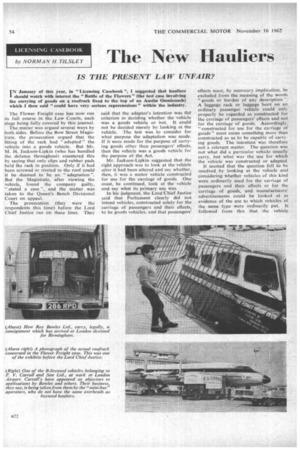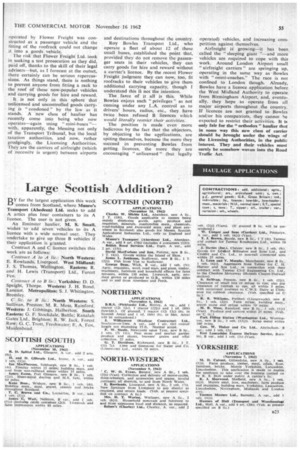The New Hauliers
Page 56

Page 57

If you've noticed an error in this article please click here to report it so we can fix it.
IS THE PRESENT LAW UNFAIR?
IN January of this year, in "Licensing Casebook ", I suggested that hauliers I should watch with interest the "Battle of the Flowers" (the test case involving the carrying of goods on a roofrack fixed to the top of an Austin Omnicoach) which I then said "could have very serious repercussions" within the industry.
The Flower Freight case has now run its full course in the Law Courts, each stage being fully covered by this journal.
The matter was argued several ways by both sides. Before the Bow Street Magistrate, the prosecution argued that the fitting of the rack had " adapted " the vehicle into a goods vehicle. But Mr. M. H. Jackson-Lipkin (who has handled the defence throughout) countered this by saying that only clips and rubber pads held the rack in position. Only if it had been screwed or riveted to the roof could it be deemed to be an "adaptation ". But the Magistrate, after viewing the vehicle, found the company guilty, " stated a case ", and the matter was taken to the Queen's Bench Divisional Court on appeal.
The prosecution (they were the respondents this time) before the Lord Chief Justice ran on these lines. They
said that the adaptor's intention was thE criterion in deciding whether the vehicle was a goods vehicle or not. It could not be decided merely by looking at the vehicle. The test was to consider for what purpose the adaptation was made. If it were made for the purpose of carrying .goods other than passengers' effects, then the vehicle was a goods vehicle for the purpose of the Act.
Mr. Jackson-Lipkin suggested that the right approach was to look at the vehicle alter it had been altered and say whether, then, it was a motor vehicle constructed for use for the carriage of goods. One must, he continued, look at the vehicle and say what its primary use was.
In his judgment, the Lord Chief Justice said that Parliament clearly did not intend vehicles, constructed solely for the carriage of passengers and their effects, to be goods vehicles, and that passengers'
effects must, by necessary implication, be excluded from the meaning of the words "goods or burden of any description ". A luggage rack or luggage boot on an ordinary passenger vehicle could only properly be regarded as constructed for the carriage of passengers' effects and not for the carriage of goods. Accordingly, "constructed for use for the carriage of goods" must mean something more than constructed so as to be capable of carrying goods. The intention was therefore not a relevant matter, The question was not what did a particular vehicle usually carry, but what was the use for which the vehicle was constructed or adapted.
It seemed that the question fell to be resolved by looking at the vehicle and considering whether vehicles of this kind were ordinarily used for the carriage of passengers and their effects or for the carriage of goods, and manufacturers' advertisements could be looked at as evidence of the use to which vehicles of the same type were ordinarily put. It followed from this that the vehicle operated by Flower Freight was constructed as a passenger vehicle and the fitting of the roofrack could not change it into a goods vehicle. , The risk that Flower Freight Ltd. took in seeking a test prosecution as they did, paid off, thanks to the skill of their legal advisers—but, as I forecast at the outset, there certainly can be serious repercussions. As things stand, there is nothing to prevent anyone from fitting a rack to the roof of these now-popular vehicles and carrying goods for hire and reward.
It is not only in this sphere that unlicensed and uncontrolled goods eariying is" condoned" by the law as it stands. A new class of haulier has recently come into being who now operates—again using mini-buses "-with, apparently, the blessing not only of the Transport Tribunal, but the local taxation authorities, and now, rather grudgingly, the Licensing Authorities. They are the carriers of airfreight (which of necessity is urgent) between airports and destinations throughout the country.
Roy Bowles Transport Ltd., who operate a fleet of about 12 of these small buses, established the point that, provided they do not remove the passenger seats in their vehicles, they can carry goods for hire and reward without a carrier's licence. By the recent Flower Freight judgment they can now, too, fit roofracks to their vehicles to give them additional carrying capacity, though I understand this II not the intention.
The farce of it all is this. While Bowles enjoys such " privileges " as not coming under any L.A. control as to drivers' hours, radius, etc., they have twice been refused B licences which would literally restrict their activities.
The position is made even more ludicrous by the fact that the objectors, by objecting to the applications, are spiting themselves, because the more they succeed in preventing Bowles from getting licences, the more they are encouraging "unlicensed" (but legally operated) vehicles, and increasing com petition against themselves. • • Airfreight is growing—it has been called the "sleeping giant "—and more vehicles are required to cope with this work. Around London Airport small " airfreight carriers " are springing up, operating in the same way as Bowles with " ornni-coaches." The race is not confined to London though. Already, Bowles have a licence application before the West Midland Authority to operate from Birmingham Airport, and, eventually, they hope to operate from all major airports throughout the country. If licences are not granted to Bowles and/or his compatriots, they cannot be expected to restrict their activities. It is only fair for the " orthodox " haulier that in some way this new class of carrier should he brought under the wings of the Licensing Authorities, in the public interest. They and their vehicles must surely be somehow woven into the Road Traffic Act.








































































































































